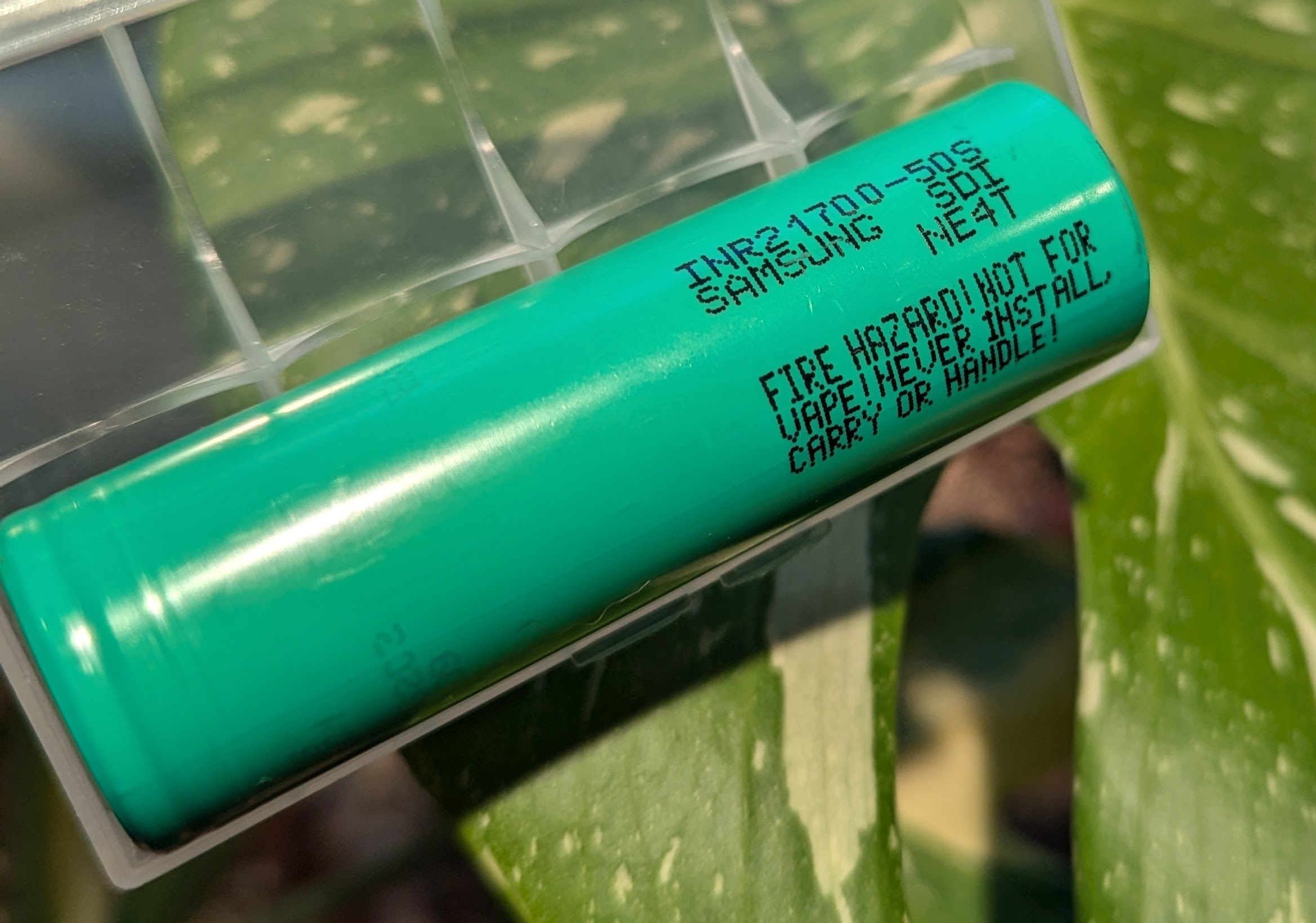At first I thought, damn a 600 mile battery. That’s a big battery.
If it were any other company I would be thrilled. With Samsung, this is going to be internet enabled, you’ll need an app to turn your car on and off, and it’ll probably play ads at high volumes constantly while driving.
I know you jest, but Samsung is a massive battery supplier.
These will be plain old dumb batteries
I dunno man, my 21700 cells just got an OTA update and now my flashlights wont turn on without watching an ad blinked out in mores code first.

“Never install, carry or handle”. OK but what are they for then?
These are cells that are meant to be assembled into larger battery packs by electronics manufacturers, like laptop batteries or e bike batteries.
The cells are fantastic for flashlights, lasers, and vapes, but Samsung does not sell them to end consumers and wishes other companies would not do that either but fuck Samsung I’m not stupid.
I am stupid. How dangerous would one of these be to me if I picked it up by the ends (Or whatever to make it discharge into my body)?
It wouldn’t be dangerous at all to do that. They can be dangerous because the cells are unprotected, so if you short the ends together with something a lot more conductive than your fingers (eg metal) the cell will very quickly overheat and possibly catch fire, since there’s no protection circuit to detect and cut off current when a short is detected.
Wait, which company had their battery blowing up ? And were not safe for flight. If these battery blew up then it would be devastating.
Aaaaaaand (deep breath)
Bullshit
600 miles? Call me when they make one small enough to fit in a car
heyooooo
It’s such a dumb metric for batteries. I wish people would stop using it.
I mean its a more a metric for the over vehicle. It can move its self that distance on a charge.
The battery would kWh but that alone is insufficient for evaluating the vehicle
kWh/Kg is really all that matters, maybe max charge/discharge rates too.
But they aren’t clickbatey enough for commercial news.
But kWh/kg doesn’t account for additional energy sinks or drive train efficiency
Sure, for a specific car, but Samsung isn’t making cars, just a battery that could go in a number of different vehicles. So all we’re really able to compare is batteries, not full vehicle efficiency.
If they’re intending to suggest this new battery, when fitted in an existing EV (say a Model Y) would result in a 600 mile range, then it’s interesting, but all other things (drivetrain, drag, vehicle weight) would have to remain constant.
Want a stupid metric? How about miles per gallon
Wait, are EV batteries even replaceable?
Not this one. It’s 600 miles long
I like this comment, because Samsung in other areas does indeed get confused about batteries being consumable.
TL;DR: Depends on what you mean.
Long version:
Disclaimer: I’m not an expert by any means, I haven’t vetted the links properly (or at all), they’re mostly there for illustration and if you want to read further. Also, the last time I actually read up on this is quite some years ago, so stuff may have changed in the industry and/or my memory on specifics is foggy. Many of the links lead to Tesla sources since I first looked into this topic back before Musk made it known to the public that he’s an insufferable human being.
Batteries are usually structurally integrated into the chassis with modern EVs, since that means space (and often small weight) savings, and is easier/faster to do in manufacturing.
With that knowledge, it is safe to assume that replacing a car’s battery is a difficult or next to impossible task, outside of end-of-life reuse.
But this is actually where it gets interesting, since EV batteries last many years anyways: What happens when the car’s time has come?
Well… the batteries can be reused. It’s not a trivial process, there’s several ways to do it, but the best intuitive explanation I’ve found is this: In raw ore, lithium and other metals are present at maybe 0.1 or 1%, per tonne of material. In batteries, it’s maybe 99% of reusable, expensive material. Even if you let it be 90 due to inefficiencies in recovery, or whatever, it’ll still make way more sense financially to work with old batteries – once you have the process figured out and automated machinery to get it done in place.
All that is assuming total destruction of the existing cells, which, depending on their state, may not even be necessary at all. In fact, it looks like all of that may not be needed for as much as >80% of batteries. Wow!
And we all know the best way to ensure companies are doing something is if the financial aspect aligns with their goals. It’s in their best self-interest to be able to and actually do this.
So: Replaceability per car – eh, doesn’t look to great. Replaceability across the industry? Perfect.
So what’s the catch? Is it the price?
FTA:
Apparently, they are also rather expensive to produce, since it warns that they will first go into the “super premium” EV segment of luxury electric cars that can cover more than 600 miles on a charge.
So yes. Expensive initially.

Samsung
Battery
/s
You’d be shocked to know how many of your non-Samsung devices are using Samsung batteries.
Needs to be an option to put these into todays EVs. You shouldn’t have to buy a brand new car to get better battery technology.
Today’s EV’s batteries will already outlast the car.
For a smaller EV It would take around 200kWh worth of battery for a 600 mile range. The current Tesla “superchargers” put out 250kWh. So whatever is going to charge this battery will have to output roughly an order of magnitude more power in order to charge the battery in 6 minutes. That’s an impressive and scary amount of energy transfer.
Edit: I don’t know where I got 6 minutes from. So not quite 10X the power for charging, but a LOT more than current chargers.
EE here. Chargers put out power in units of kW, while batteries store energy in units of kWh or MJ or what have you. Otherwise, you’re absolutely correct.
Typically Distributed Generation (DG) scale solar PV and battery storage sites are sized anywhere from 1 to 10 MW.
At 1 MW, you could run (1) charger at a speed of 1 MW, or (2) at 500 kW, etc. Usually need just (1) transformer for that size installation too.
At 10 MW, you can run each charger at 1 MW or so, but you’re also talking about probably (4-10) transformers @ $250k USD a pop. Installation prices go up the more you demand in power transfer.
Then you need to consider that most DG projects need to pay for the upgrades to their downstream grid architecture, meaning reconducting or upsizing cable, breakers, switches, transformers, reactors, sensors, relays, etc.
Not saying it’s impossible. You could co-locate and DC-couple solar PV or Wind parks next to charging points to get around some of the grid upgrades, but most people live in areas that require homes and grocery stores and other buildings than flat land meant for solar PV or Wind.
When it comes down to it, it’s so much easier to just trickle charge your EV at night via arbitrage and when you’re sleeping so all of this infrastructure doesn’t have to been upgraded - and I’d argue upgraded needlessly because we need to save that copper and iron and materials for upgrades to the parts of the grid meant to interconnect renewables.
But there is no silver bullet to these things so we’ll likely see more, larger chargers come through unless regulators stop it from happening.
A couple things: solid state batteries weigh much less. Solid state batteries are 30-50% lighter per kWh. The initial ones will probably be closer to 30% lighter. A 100 kWh battery weighs about 1400 lbs (635 kg). Shaving off 400 lbs is pretty significant and results in much better range for the same battery capacity. The battery pack is likely closer to 150 kWh.
Second thing would be the charge rate. Yes, a supercharger can 250 kW output (not kWh BTW) but a few factors means that they often do not. First thing would be heat. If the charging cable or the battery gets too hot, the the rate slows down. The next thing would be the fact that current batteries have to start at a slow rate and end at a slow rate. Solid state batteries do not have those issue nearly as much and can more consistently hit that 250 kW output for a longer period of time.
This thing, they are likely using 350+ kW chargers. Higher than 350 kW is pretty rare but the odd 400 kW and 450 kW charger does exist.
And doing some more digging, I found that it is from 8% to 80% in 9 minutes. And even then, it does not say it is the same 150 kWh battery that is being charged that fast. This could be marketing crap where it is giving numbers for a ~85 kWh battery to compare it to EVs today. An Ioniq 5 takes about twice as long to go from 10-80% at 350 kW.
The current Tesla “superchargers” put out 250kWh
kW
My wall outlet charger puts out 250 kWh, if you leave it in for 2 weeks straight…





